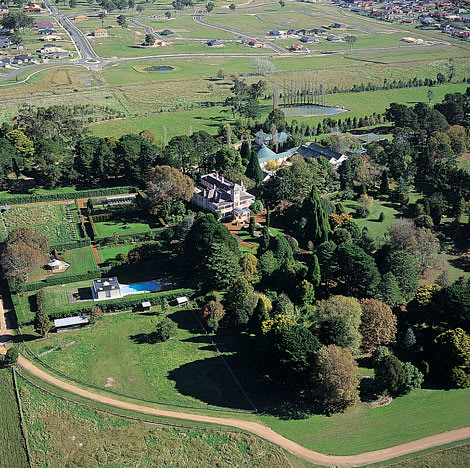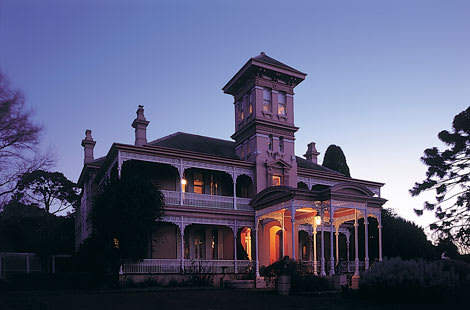Retford Park and Markdale: Glorious gardens to thrive beyond Open Gardens' demise
After 27 years of opening private gardens to the public, Open Gardens Australia has announced that its present season would be its last.
Open Gardens Australia started in Victoria before going interstate and has been behind the opening of almost 20,000 private gardens across Australia to the public.
In its heyday more than 800 gardens opened annually, but just under 500 gardens will be open this season.
Only last week Australia Post announced that it would be featuring five beautiful private gardens from Open Gardens Australia in a new stamp issue.


There were five domestic base rate (70c) stamps and products available, although the website indicates that they are currently out of stock.

Our shocked and saddened property contrarians Jonathan Chancellor and Margie Blok have been to many of them - certainly never taking unauthorised plant samples - and now nominate their favourite garden tour.
HE SAID:

It has to be Retford Park, established by Samuel Hordern in 1887.
James Fairfax now is the keeper of the English park and garden that features magnificent trees, mature shrubberies and hedged garden rooms, all sustainably managed using organic principles.
Rhododendrons and azaleas at their peak in October. Century old bunya bunyas, redwoods and oaks impressed. I recall the more freshly planted Wollemi pines.
There's an impressive collection of classical and contemporary sculptures and that marvelled Guilford Bell swimming pool pavilion.
One later occasion on a private visit, Jeffrey Smart was there strolling the grounds. Sadly no painting ever emerged to immortalise the pavilion.
Of course as I've previously reported, the philanthropic former newspaperman James Fairfax intends to gift his historic Retford Park estate in the NSW Southern Highlands.
Its envisaged the Italianate 1887 residence will sit within a protected 32-hectare heritage curtilage.
It will be preserved in perpetuity for the community with some funds from the neighbouring prestige residential development being directed into a trust which will pay for the long-term upkeep of the home and gardens.
The gifting won't take place until subdivision sales take place. I notice they are progressing quite well.
The Old South Road property, which sits on the southern edge of Bowral’s rapidly suburban expansion, has long sat on about 100 hectares including the land now zoned for subdivision.

Under the proposal, the 29-hectare eastern part of the estate has been subdivided into rural-inspired lots ranging from 8,000 square metres to four hectares lots.
The philanthropic former chairman of the ailing publishing company that bears his family name, first advised he would bequeath Retford Park for the benefit of the public in an article written by me in 2009 in the Sydney Morning Herald. It was his idea for at least three decades.
Retford Park has been the country home of the arts patron since he paid £15,000 in 1964 for it on a then four-hectare holding.

Retford Park, with an Italianate revival-style mansion, dates back to the 1880s when it was the summer retreat of the retailing Hordern family.
"I think Retford Park is an important part of the heritage of the Wingecarribee Shire area and provision has been made in my will for the house and the immediate surrounding land, including the garden, to be left in trust to be viewed by future generations," Mr Fairfax told me in 2009.
Listed on the register of the national estate since 1980, Retford Park takes its name from the village in Nottinghamshire, the northern England town from where Anthony and Ann Hordern immigrated in 1825.
The grounds have many heritage oaks, an enduring association with the Hordern's retailing business, whose emblem was an oak tree under which were the words: "While I live, I'll grow".

It was first sold after Anthony's great-grandson, Sir Samuel Hordern, died in 1956, leaving an estate of $279,000. It was briefly owned by the cattle stud operator King Ranch (Australia), of which Edwina Hordern's husband, Peter Baillieu, was managing director.
In his 1991 book, Regards to Broadway, Fairfax recollected he'd had no plans to buy a country house. "But chatting to Peter Baillieu at a cocktail party in December 1963, I learned that Retford Park and 10 acres [four hectares] of land were to be sold."
It occurred to James that it might be a suitable place for his mother to stay on her annual six month visits from England.
Fairfax, the eldest son of the late Sir Warwick Fairfax and his first wife, Betty Wilson, then set about regularly buying adjoining rural land.
He also set about enlivening the house.
"When my offer of £15,000 for the house and 10 acres with an option to buy another 10 in three years was accepted, I went into the usual ‘What on earth have I taken on?’ syndrome, but soon recovered as I got involved in the redecoration which was being done by Leslie Walford," he recalled to Sue Rosen in 2011.
"Some six months later, in the winter of 1964, I commissioned Donald Friend to paint a mural in the dining room," he said.
Leslie Walford, who died earlier this year, said in a 2011 interview with Rosen that he recalled flying up to Mittagong with James to inspect the house.
His first impressions of it was "the garden choking the house".
"The house was a sort of cow-pat colour, a very unappealing colour. It had thick walls and narrow long slit windows and a tower, a rectangular piece of work with lots of frilly balconies, cast-iron lace and a pretty porte cochere. It had some delicate prettiness added to the strength of the architecture … it was a wonderful looking house."
Colour photos courtesy of Highlife Magazine, which reports on life in the Southern Highlands of Australia.
Margie Blok has her say on the next page. Please click below.

SHE SAID:
It’s Markdale for me. Acknowledged as one of the great country gardens of Australia, this magnificent garden was part of the Australia’s Open Garden Scheme for many years.
The garden surrounds the homestead of Markdale, a 6,000 acre rural property at Binda, a tiny hamlet near Crookwell in the Southern Tablelands of New South Wales. Owned by the Ashton family for three generations, the garden began during the 1920s and was re-designed in 1949 by Edna Walling, one of Australia’s most influential landscape designers.

Markdale Homestead. Photo: Danny Kildare. Source: Markdale.com.
The award-winning five-acre garden is featured in many books and magazines on Australian gardening. Extensively rejuvenated in recent years, it has a wealth of beautiful features including a long pergola of blue and white wisteria, dry stone walls, dozens of specimen trees, sweeping lawns and a beautiful lake with a Chinese bridge.
Under the Ashton family’s guidance, the garden retains its strong influence of Walling’s design and plantings. It remains substantially as she planned it - sweeping lawns merging with mown paddock, and informal curved paths leading the eye into hidden depths of the garden and then out to the hills beyond.
During her career Walling’s style changed very little, yet each of her garden designs is individual. One of her signatures is the use of stone in low fences, paths and steps to give architectural structure to a garden, and then softening it with dense planting. Her design principles also include creating unity between the garden and the house, while working with the existing landscape and existing features including slopes and trees.
At Markdale, Walling’s design took advantage of the glorious natural scenery of paddocks and hills. Framing the garden without obscuring the beautiful views to the hills are magnificent trees including golden elms, golden ash and claret ash, silver birch, pinoaks, hawthorns, aspens, spireas, viburnums and native eucalypts.
At the same time Walling was working on the garden, the Ashtons commissioned architect Professor Leslie Wilkinson to redesign the homestead. This unique partnership of Walling and Wilkinson has never been repeated.

Source: Markdale.com.
It was Geoff Ashton (one of four sons of James Ashton who built the original homestead) and his wife, Janet, who hired Walling and Wilkinson. For the past three decades, their son, also named Geoff, and his wife Mary, have maintained the garden, homestead and property.
They have thought about selling it on and off over the past decade, and I know would simply love for a buyer to emerge who has a passion for the property.
Although Walling’s outline of the garden has changed little, the existing beds have been replanted and developed under the skillful guidance of Mary Ashton. She and her husband took the reins at Markdale in 1983 during one of the worst droughts in recorded history. Sadly, many plants in the garden died during that drought.
Faced with the enormous task of restoring the Markdale garden, Mary extensively read and researched Walling’s methods and principles to gain insight into her original intent for its design.
Mary took a careful and considered approach to the garden before developing layers of thick planting in beds and borders beside the stone pathways leading to various garden areas which provide a different view from each direction.

Source: Markdale.com.
But the Markdale garden is as much about the use of space and architecture as it is about planting. One of its focal points is the lake, and Walling was justifiably proud of its design.
Among documents held in the Edna Walling Collection, of the La Trobe Australian Manuscripts Collection at State Library of Victoria, is a letter written by Walling to Miss Mervyn Davis that describes her inspiration for the Markdale lake.
Dated 7 June 1965, Walling’s letter reads: “Dear Mervyn,Re “Markdale”... The best thing I did there was to deal with the erosion in the paddock over which I was taken for a walk on Sunday morning. It was within view of the living room window and when Mrs Ashton told me of their plan to build a series of ... concrete barriers right down the deep ... It seemed to me a pretty poor idea. "Why not dam it back and have a lake" I sez!”
About two and a half hours drive from Sydney, Markdale is a must see for people with a passion for gardens.
And at the property, the Ashton family offer self-catered bed and breakfast accommodation for up to 24 people in two original 1850s stone houses and shearers quarters.
